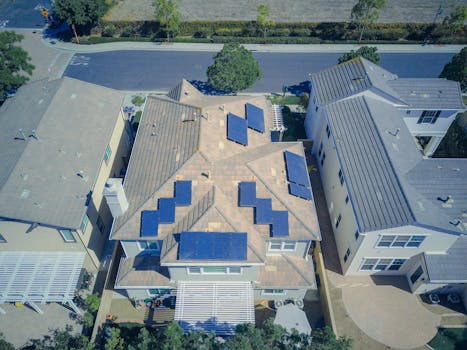“Power Up Your Savings: Maximize Efficiency with Solar Battery Storage!”
Maximizing efficiency with solar battery storage systems involves optimizing the use of solar energy by storing excess power generated during peak sunlight hours for later use. This technology enhances energy independence, reduces reliance on the grid, and minimizes energy costs. By integrating solar panels with battery storage, homeowners and businesses can effectively manage their energy consumption, ensuring a steady supply during periods of low sunlight or high demand. Additionally, these systems contribute to a more sustainable energy future by facilitating the use of renewable resources, reducing carbon footprints, and promoting energy resilience. As advancements in battery technology continue to evolve, the potential for increased efficiency and cost-effectiveness in solar energy systems becomes increasingly attainable.
Benefits Of Solar Battery Storage Systems
As the world increasingly turns to renewable energy sources, solar battery storage systems have emerged as a pivotal component in maximizing the efficiency of solar energy utilization. These systems not only enhance the performance of solar panels but also provide a myriad of benefits that contribute to energy independence, cost savings, and environmental sustainability. One of the most significant advantages of solar battery storage is the ability to store excess energy generated during peak sunlight hours. This stored energy can then be used during periods of low sunlight or at night, ensuring a continuous power supply. Consequently, homeowners and businesses can reduce their reliance on the grid, which is particularly beneficial during peak demand times when electricity prices tend to soar.
Moreover, solar battery storage systems play a crucial role in enhancing energy resilience. In an era where power outages and grid instability are becoming more common due to extreme weather events and aging infrastructure, having a reliable backup power source is invaluable. With a solar battery system in place, users can maintain essential functions during outages, thereby safeguarding their homes and businesses from disruptions. This resilience not only provides peace of mind but also protects against potential financial losses associated with downtime.
In addition to energy independence and resilience, solar battery storage systems can lead to significant cost savings over time. By storing energy generated during the day, users can avoid purchasing electricity from the grid during peak hours when rates are highest. This practice, known as load shifting, allows consumers to optimize their energy usage and reduce their overall electricity bills. Furthermore, many regions offer incentives and rebates for the installation of solar battery systems, which can further offset initial costs and enhance the return on investment.
Transitioning to solar battery storage also aligns with broader environmental goals. By maximizing the use of renewable energy, these systems contribute to a reduction in greenhouse gas emissions and reliance on fossil fuels. As more individuals and businesses adopt solar technology, the cumulative effect can lead to a significant decrease in carbon footprints, promoting a cleaner and more sustainable future. Additionally, the integration of solar battery storage with smart home technology allows for more efficient energy management. Users can monitor their energy consumption in real-time, adjust usage patterns, and even automate energy storage based on predictive algorithms. This level of control not only enhances efficiency but also empowers users to make informed decisions about their energy consumption.
Furthermore, as technology continues to advance, the efficiency and affordability of solar battery storage systems are expected to improve. Innovations in battery technology, such as lithium-ion and solid-state batteries, are paving the way for longer-lasting and more efficient storage solutions. As these technologies become more accessible, the adoption of solar battery systems is likely to increase, further driving down costs and enhancing the overall viability of solar energy as a primary power source.
In conclusion, the benefits of solar battery storage systems are multifaceted, encompassing energy independence, resilience, cost savings, and environmental sustainability. As the demand for renewable energy solutions continues to grow, investing in solar battery storage not only maximizes the efficiency of solar energy systems but also contributes to a more sustainable and resilient energy future. By harnessing the power of the sun and effectively managing energy storage, individuals and businesses can play a vital role in the transition to a cleaner, more efficient energy landscape.
How To Choose The Right Solar Battery For Your Needs

Choosing the right solar battery for your needs is a critical step in maximizing the efficiency of your solar energy system. As the demand for renewable energy sources continues to grow, understanding the various options available can empower homeowners and businesses alike to make informed decisions. The first consideration when selecting a solar battery is the capacity, which is typically measured in kilowatt-hours (kWh). This figure indicates how much energy the battery can store and subsequently supply. To determine the appropriate capacity for your needs, it is essential to assess your energy consumption patterns. By analyzing your monthly electricity bills, you can identify peak usage times and calculate the total energy required during those periods.
Once you have a clear understanding of your energy needs, the next factor to consider is the depth of discharge (DoD). This term refers to the percentage of the battery’s capacity that can be used before it needs to be recharged. A higher DoD allows for more usable energy, which can be particularly beneficial during periods of low solar production, such as cloudy days or nighttime. Therefore, selecting a battery with a high DoD can enhance the overall efficiency of your solar energy system, ensuring that you have access to stored energy when you need it most.
In addition to capacity and DoD, the chemistry of the battery plays a significant role in its performance and longevity. The most common types of solar batteries include lead-acid, lithium-ion, and flow batteries. Lead-acid batteries are often more affordable upfront but tend to have a shorter lifespan and lower efficiency compared to lithium-ion batteries. On the other hand, lithium-ion batteries, while initially more expensive, offer greater efficiency, longer lifespans, and higher DoD capabilities. Flow batteries, although less common, provide unique advantages in scalability and longevity, making them suitable for larger installations. Understanding the pros and cons of each battery type will help you make a more informed choice based on your specific requirements and budget.
Furthermore, it is essential to consider the inverter compatibility when selecting a solar battery. The inverter is responsible for converting the direct current (DC) generated by solar panels into alternating current (AC) for use in your home or business. Not all batteries are compatible with every inverter, so it is crucial to ensure that the battery you choose can seamlessly integrate with your existing solar system. Consulting with a professional installer can provide valuable insights into the best combinations of batteries and inverters for optimal performance.
Another important aspect to evaluate is the warranty and support offered by the manufacturer. A robust warranty can provide peace of mind, as it indicates the manufacturer’s confidence in their product’s durability and performance. Additionally, consider the availability of customer support and service options, as these can be vital in addressing any issues that may arise during the battery’s lifespan.
Ultimately, selecting the right solar battery involves a careful assessment of your energy needs, budget, and the specific characteristics of available battery options. By taking the time to evaluate these factors, you can ensure that your investment in solar battery storage will enhance the efficiency of your solar energy system, providing reliable power and contributing to a more sustainable future. As the renewable energy landscape continues to evolve, making informed choices will empower you to harness the full potential of solar energy and enjoy the benefits of energy independence.
Strategies For Optimizing Solar Battery Performance
Maximizing efficiency with solar battery storage systems is essential for homeowners and businesses looking to harness renewable energy effectively. To achieve optimal performance from these systems, several strategies can be employed, each contributing to enhanced energy management and cost savings. Understanding the intricacies of solar battery technology is the first step toward optimizing its performance. Solar batteries store excess energy generated during peak sunlight hours, allowing users to draw on this stored energy during periods of low sunlight or high demand. However, the efficiency of this process can be significantly influenced by how the system is managed.
One of the primary strategies for optimizing solar battery performance is to ensure that the battery is appropriately sized for the energy needs of the household or business. An undersized battery may lead to frequent discharges, which can reduce its lifespan and efficiency. Conversely, an oversized battery can result in unnecessary costs and underutilization of the system. Therefore, conducting a thorough energy audit to assess consumption patterns and peak usage times is crucial. This information can guide the selection of a battery that meets specific energy requirements without excess capacity.
In addition to proper sizing, regular maintenance of the solar battery system is vital for sustaining its performance. This includes monitoring the battery’s state of charge and ensuring that it operates within the recommended temperature range. Extreme temperatures can adversely affect battery efficiency and longevity. By implementing a routine maintenance schedule that includes checking connections, cleaning terminals, and updating software, users can prevent potential issues that may hinder performance.
Moreover, integrating smart technology into solar battery systems can significantly enhance their efficiency. Smart inverters and energy management systems allow users to monitor energy production and consumption in real-time. This data can inform decisions about when to store energy and when to draw from the battery, optimizing usage based on current energy needs and market conditions. For instance, during times of high electricity rates, users can rely on stored energy instead of drawing from the grid, leading to substantial savings.
Another effective strategy involves utilizing time-of-use (TOU) pricing structures offered by many utility companies. By understanding peak and off-peak pricing, users can strategically charge their batteries during low-cost periods and discharge them during high-cost periods. This not only maximizes savings but also contributes to grid stability by reducing demand during peak times. Additionally, users can program their systems to prioritize self-consumption, ensuring that they utilize stored energy before relying on grid power.
Furthermore, considering the installation of additional renewable energy sources, such as wind turbines or micro-hydro systems, can complement solar battery storage. By diversifying energy generation methods, users can enhance their energy independence and reliability. This approach not only maximizes the use of available resources but also provides a buffer against fluctuations in solar energy production due to weather conditions.
Lastly, staying informed about advancements in solar battery technology is essential for optimizing performance. As the industry evolves, new technologies and strategies emerge that can further enhance efficiency and reduce costs. Engaging with professional installers and energy consultants can provide valuable insights into the latest developments and best practices in solar battery management.
In conclusion, optimizing solar battery performance requires a multifaceted approach that includes proper sizing, regular maintenance, smart technology integration, strategic energy management, and ongoing education. By implementing these strategies, users can maximize the efficiency of their solar battery systems, ultimately leading to greater energy independence and cost savings.
Common Mistakes To Avoid With Solar Battery Storage
As the adoption of solar energy continues to rise, many homeowners and businesses are increasingly turning to solar battery storage systems to maximize their energy efficiency. However, while these systems offer significant benefits, there are common mistakes that can hinder their effectiveness. Understanding and avoiding these pitfalls is crucial for anyone looking to optimize their solar energy usage.
One of the most prevalent mistakes is underestimating the importance of proper sizing. Many individuals purchase a solar battery system without fully assessing their energy needs. This can lead to either over-investing in a system that is too large or, conversely, selecting a battery that cannot adequately support their energy consumption. To avoid this, it is essential to conduct a thorough energy audit, taking into account daily usage patterns and peak demand times. By accurately sizing the battery, users can ensure that they have sufficient storage capacity to meet their needs without incurring unnecessary costs.
Another common error is neglecting to consider the battery’s lifespan and warranty. Solar batteries are not a one-time investment; they require careful consideration of their longevity and the terms of their warranties. Many users fail to read the fine print, which can lead to unexpected costs down the line. It is advisable to choose batteries with a solid warranty and a proven track record of durability. Additionally, understanding the expected cycle life of the battery can help users gauge how often they will need to replace it, allowing for better long-term financial planning.
Moreover, improper installation can significantly impact the performance of solar battery systems. Many users opt for DIY installations or hire unqualified technicians, which can lead to inefficiencies and safety hazards. It is crucial to engage certified professionals who are experienced in solar battery installations. Proper installation not only ensures optimal performance but also maximizes safety, reducing the risk of malfunctions or accidents.
In addition to installation, overlooking maintenance is another mistake that can diminish the efficiency of solar battery systems. While these systems are generally low-maintenance, they still require periodic checks to ensure they are functioning correctly. Users should familiarize themselves with the maintenance requirements of their specific battery model and schedule regular inspections. This proactive approach can help identify potential issues before they escalate, ensuring that the system operates at peak efficiency.
Furthermore, failing to integrate the solar battery system with existing energy management systems can lead to missed opportunities for optimization. Many users do not take full advantage of smart technology that can monitor energy usage and adjust storage accordingly. By integrating the battery with home automation systems, users can optimize energy consumption, ensuring that they are using stored energy when it is most beneficial, such as during peak pricing periods.
Lastly, many individuals overlook the importance of understanding local regulations and incentives related to solar battery storage. Each region has its own set of rules, rebates, and tax incentives that can significantly affect the overall cost and efficiency of solar battery systems. By staying informed about these regulations, users can take advantage of available incentives, making their investment more financially viable.
In conclusion, while solar battery storage systems present an excellent opportunity for maximizing energy efficiency, avoiding common mistakes is essential for achieving optimal performance. By ensuring proper sizing, professional installation, regular maintenance, integration with energy management systems, and awareness of local regulations, users can fully harness the benefits of solar energy and enjoy a more sustainable future.
Q&A
1. **Question:** What is the primary benefit of integrating solar battery storage systems with solar panels?
**Answer:** The primary benefit is the ability to store excess solar energy generated during the day for use during the night or during periods of low sunlight, maximizing energy utilization and reducing reliance on the grid.
2. **Question:** How do solar battery storage systems improve energy cost savings?
**Answer:** They allow homeowners and businesses to use stored energy during peak pricing hours, reducing electricity bills by minimizing the need to purchase energy from the grid when rates are highest.
3. **Question:** What factors should be considered when selecting a solar battery storage system for maximum efficiency?
**Answer:** Key factors include battery capacity, discharge rate, cycle life, efficiency rating, compatibility with existing solar systems, and the specific energy needs of the household or business.
4. **Question:** How can solar battery storage systems contribute to energy resilience?
**Answer:** They provide backup power during outages, ensuring that critical appliances and systems remain operational, thus enhancing energy security and resilience against grid failures.
Conclusion
Maximizing efficiency with solar battery storage systems involves optimizing the integration of solar energy generation and energy storage to ensure that excess energy produced during peak sunlight hours is effectively stored and utilized during periods of low generation. This can be achieved through strategic sizing of battery systems, implementing advanced energy management systems, and utilizing smart technology to monitor and control energy flow. By enhancing the efficiency of solar battery storage, users can reduce reliance on grid power, lower energy costs, and contribute to a more sustainable energy future. Ultimately, the effective use of solar battery storage systems not only maximizes energy efficiency but also promotes energy independence and resilience.




